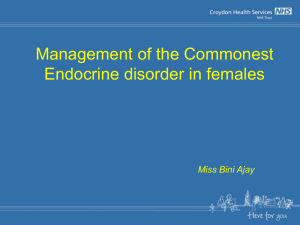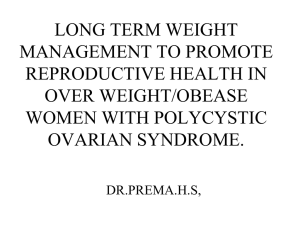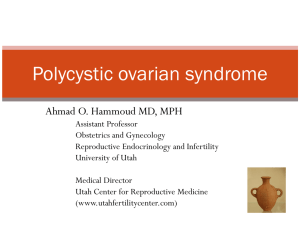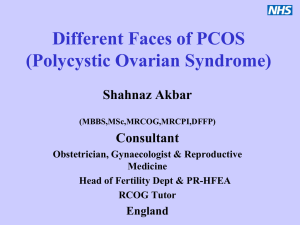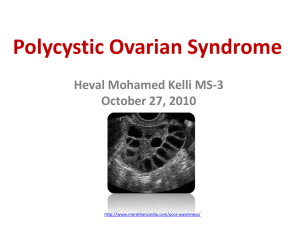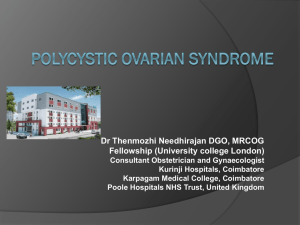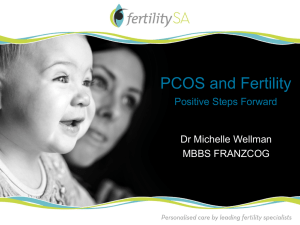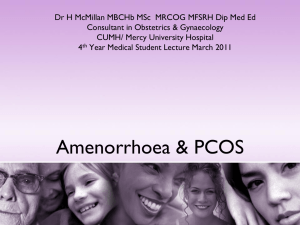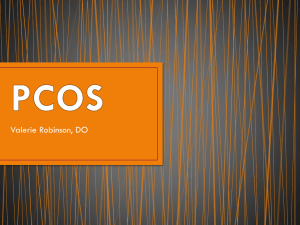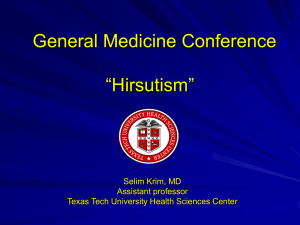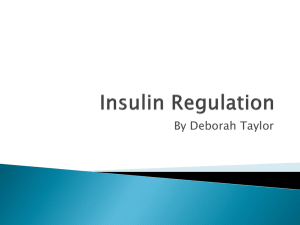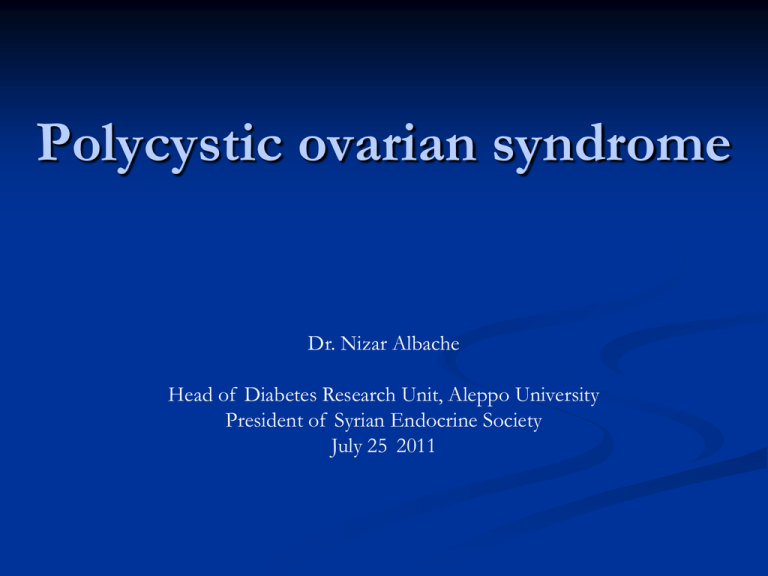
Polycystic ovarian syndrome
Dr. Nizar Albache
Head of Diabetes Research Unit, Aleppo University
President of Syrian Endocrine Society
July 25 2011
Key Learning Objectives
To be able to recognize and diagnose PCOS
To understand the lifelong manifestations of
PCOS
To understand management options for:
longterm health
hirsutism
infertility
Prevalence & Diagnosis
PCOS - past and present
Stein-Leventhal Synd.
Menstrual disorder
Hirsutism
Obesity
Infertility
PCO
Stein IF, Leventhal ML. Am J Obstet Gynecol. 1935;29:181-191.
The celebrated “La Barduba”
by Ribera, a 52-year-old lady
nursing her child. She became
markedly hirsute at age 37
after
having
had
spontaneous abortions.
three
FREQUENCY OF PCOS
•General
population
•Women with secondary amenorrhea
• women with oligomenorrhea
•Women with hirsutism
•Normal women met the sonographic criteria for pcos
•Anovulation in women diagnosed with pcos 75%
•Anovulation in hirsute women with normal menses
4% - 8%
30%
75%
90%
23%
40%
How to make a diagnosis
Clinical suspicion
Primary or secondary amenorrhoea
Oligomenorrhoea
Unexplained infertility
Acne/ hirsutism
Obesity
HIRSUTISM :
excessive growth of body hair in women at androgen-dependent areas:
very few hairs are found
- LIPS
- CHIN
- CHET
- ABDOMEN
- BACK
- FEMORAL REGION
where normally
HIRSUTISM CLASSIFICATION
From Slight Hirsutism To Virilim
Ferriman-Gallwey score :
9 areas
Score = 0 – 4
N=6–8
HIRSUT >8
VIRILISM 36
VERY SUBJECTIVE
18% OVERLAP
REPORTERS DIFFERENCES
NO FLEXIBILITY
Change in the form and rate of hair growth
* Recently: a technique for assessing Hirsutism :
video equipment and computer software.
Digital imaging of hair development
Criteria For The Diagnosis Of Polycystic
Ovary Syndrome (Pcos)
NIH (1990)
TO INCLUDE ALL OF THE FOLLOWING:
1: HYPERANDROGENISM AND/OR
HYPERANDROGENAEMIA
2: OLIGO-OVULATION
3: EXCLUSION OF RELATED DISORDERS
ESHRE/ARMS (ROTTERDAM
TO INCLUDE TWO OF THE FOLLOWING,
INCLUDING THE EXCLUSION OF
2003)
RELATED DISORDERS:
1: OLIGO- OR ANOVULATION
2: CLINICAL AND/OR BIOCHEMICAL SIGNS OF
HYPERANDROGENISM
3: POLYCYSTIC OVARIES
ANDROGEN EXCESS SOCIETY (2006)
TO INCLUDE ALL OF THE FOLLOWING:
1: HIRSUTISM AND/OR HYPERANDROGENAEMIA
2: OLIGO-ANOVULATION AND/OR POLYCYSTIC
OVARIES
3: EXCLUSION OF ANDROGEN EXCESS OR
RELATED DISORDERS
PCOS definition
Chronic Anovulation and Hyperandrogenism
5-10% reproductive age women
Diagnosis: 2/3 criteria *
1. Oligo-ovulation &/or anovulation
2. Hyperandrogenism (clinical or biochemical)
3. Polycystic ovaries on ultrasound (PCO)
* other causes for hyperandrogenism excluded
ESHRE/ASRM PCOS Consensus Workshop May 2003
Diagnosis: PCO on ultrasound
At least 1 ovary with 12+ follicles 2-9mm
&/or ovarian volume > 10mls
NB: US picture on 1 occasion suffices for
diagnosis
25% of women have PCO,
but only 5% have PCOS
ESHRE/ASRM PCOS Consensus Workshop May 2003
Differential diagnosis of PCOS:
The differential diagnosis of hirsutism &
oligomenorrha includes:
- congenital adrenal hyperplasia
- cushing syndrome
- hyperthecosis ovarii
- benign & malignant androgen
secreting tumors or ovaries.
Causes &
Mechanisms
Pathophysiology of PCOS:
PCOS is a condition that originates possibly at the time
of puberty due to interplay of:
(1) obesity & excess of ovarian androgen
production,
due to hyperinsulinemia
(2) intrauterine environment.
(3) genetic factors both X-linked, autosomal
dominant modes of inheritance.
(4) disturbance to hypothalamic-pituitary-ovarian axis.
Causes
Syndrome = a collection of symptoms and signs. There is
no single cause but multiple predisposing factors.
Genetic
Family linkage studies
Over 70 candidate genes investigated
Steroidogenic & insulin pathways, ovarian follicle development
Candidate genes may regulate hypothalamic-pituitaryovarian axis, as well as those resposible for insulin
resistance
Environmental
Fetal programming/ ‘thrifty gene hypothesis’
Obesity
Insulin Resistance
Insulin resistance (IR):
is a prominent feature in both obese (65-90%) and lean (25-45%)
women with PCOS
is unique to PCOS as occurs independently to obesity, but is
aggravated by obesity
(Franks S 1989; Dunaif A 1994)
Weight increase
SHBG
decreases
Inherited defects
in insulin actions
Insulin increase
Insulin receptor
disorders
Theca (IGF-II,
?IGF-I)
IGFBP-1
decrease
By direct inhibition of hepatic synthesis of SHBG & IGFBP -1
Intrauterine Environment &
PCOS:
Hague et al 1988 postulated that the intrauterine
environment has a role in the pathogenesis of PCOS, &
suggested that hyperandrogenism during fetal life may
be the determining factor.
The apparent influence of intrauterine milieu in poorly
controlled diabetics who end with stillborn fetuses,
showed ovarian changes similar to those seen in PCOS.
Compensatory
Hyperinsulinemia
Insulin resistance
?
Androgens
Ovary
Cause-and-effect
relationship
Serum insulin
Pathophysiology
Insulin acts synergistically with lh to enhance
androgen production in the ovarian theca
cells
Insulin also decreases hepatic synthesis and
secretion of sex hormone-binding globulin
Women with pcos and hyperinsulinemia
typically have elevated free testosterone
but the total testosterone concentration may be
at the upper range of normal or only
modestly elevated
PCOD
Obese
Non-obese
GH
LH
Different
hormone
concentrations
in obese and
non-obese PCO
patients
LH and IGF-I
effect
on theca cells
Insulin resistance
Hyperinsulinemia
IGFBP-I
IGF-I
Cytochrome
p-450c 17-alpha activity
Androgen secretion
SHBG
Insulin resistant and non-resistant PCOS
18
37 patients
19
Insulin resistant
Non-insulin resistant
Weight/height
2
P<0.0001
40
P<0.02
P<0.017
40
P<0.0001
20
P=NS
20
P<0.027
BMI
Meirow et al. Hum Reprod 1995
LH
Andr
Test
SHBG
Estrad
Role of leptin in the
pathophysiology of PCOS:
Leptin is considered as one of the major
peripheral signals that affects food intake &
energy balance.
Obesity is a classic condition of circulating leptin
excess.
Leptin (OB)
16 KDa protein encoded by ob
gene.
Expressed & secreted by –
adipocytes, placenta, gastric
epithelium.
Directly proportional to the
total amount of fat in the
body.
mice are homozygous for single
gene mutation.
ob/ob –protein hormone
leptin
db/db –receptor for leptin .
High degree of homology
Role of leptin in the
pathophysiology of PCOS:
The discrepancy between increased leptin blood
levels & its central effects represents a leptin
resistance as shown by study of Moschos et al
2002 in Fertility Sterility Journal.
Mitchell m in 2005, there is evidence that leptin
acts directly on the ovaries through functional
receptors defect.
Role of leptin in reproduction
Fertility influenced by stored body fat
Leptin signals the onset of puberty .
Regulates hypothalamic- pituitary – ovarian
function .
Signalling Pathway of Leptin
Action
Potential Role Of The
Endocannabinoid System
involved in the dynamic & homeostatic regulation of
feeding & energy metabolism.
regulate multiple endocrine functions including H-P-O
axis
fluctuates during ovarian cycle in both the
hypothalamus & pituitary, thus influencing hormonal
secretion & sexual behavior through CB1 receptor
activation
Despite JP et al 2005 used rimonabant in patients as a
new pharmacological treatment for tackling obesity
Table :Representative Candidate Genes with Evidence of Linkage,
Association, or Both, with the Polycystic Ovary Syndrome (PCOS)
Pathway and protein (Gene)
Insulin secretion and action
Insulin receptor (INSR) region-D195884
Insulin variable-number tandem repeats (VNTR)
Insulin receptor substrate 1 (IRS-1)
Insulin receptor substrate 2 (IRS-2)
Calpaim 10 (CAPN10)
Peroxisome-proliferator-activated receptor g (PPAR g)
Protein phosphatase 1 regulatory subunit (PPP1R3)
Gonadotropin secretion and action
Follistatin (FST)
Androgen biosynthesis, secretion, transport, and metabolism
Androgen receptor (AR)
Sex hormone-binding globulin (SHBG)
Cytochrome P450c17 (CYP17)
Cytochrome P-45011a (CYP11a)
11b-hydroxysteroid dehydrogenase (11b-HSD) and hexose-6-phosphate dehydrogenase (H6PD)
life-long condition
PCOS is a life-long condition
Cancer (uterine; ?breast)
Hirsutism
Menstrual irregularities
Hypercholesterolaemia
Diabetes
Hypertension
? Pronounced adrenarche
Infertility, miscarriage
Gestational hypertension
Gestational diabetes
? IUGR
0
Longterm
health
10
20
Precocious
puberty
30
40
Reproductive
disorder
50
Coronary heart disease
60
70
Age (years)
Metabolic syndrome
PCOS and glucose intolerance
Increased prevalence of glucose intolerance (35%) and
type 2 diabetes (10%)
Also increased in non-obese PCOS (10%, 1.5%)
Increased risk (x3-7) of developing type 2 diabetes
PCOS women develop glucose intolerance at an early age
(3rd-4th decade)
PCO is risk factor for gestational diabetes
Long-term health risks
Established:
Reproductive: Endometrial Cancer
Metabolic: Diabetes, Dyslipidaemias, Hypertension, Obesity
Unproven:
Cardiovascular Disease
Breast cancer
Acanthosis Nigricans ( An ) Is A
Clinical Marker Of Ir
“Velvety, mossy, verrucous, hyperpigmented skin change often found over the
nape of the neck, in the axillae or beneath the breasts
Caused from the binding of insulin to insulin-like growth factor receptors on
keratinocytes and fibroblasts which results in hyperplasia of the skin
IR is present in more than 90% of patients with AN
Evaluation
The 3 steps of androgen metabolism in women
Adapted from: Beylot C. et al. Oral Contraceptives and Cyproterone Acetate in
Female Acne Treatment. Dermatology 1998; 196: 148-152.
Investigations
Serum (early follicular phase):
LH/FSH
Total testosterone, Free androgen index (FAI)
Exclude other endocrinopathies
*TSH, Prolactin, DHEAS, 17-OH progesterone
Pelvic ultrasound scan for the ovarian features
of PCO
Diabetes screen, lipid profile , BP check
Hormone levels: PCOS vs. Idiopathic hirsutism
Baseline plasma hormone levels in patients with PCOS or
idiopathic hirsutism and in healthy women (mean values)
Hormone
PCOS
n=213
LH (IU/L)
FSH (IU/L)
Androstenedione (µg/L)
Testosterone (T) (µg/L)
Free T (ng/L)
DHEAS (mg/L)
3a-diolG (µg/L)
SHBG (nmol/L)
14.3*
5.3
3.6*
1.0*
3.6*
2.9*
6.3**
22.1*
Idiopathic
hirsutism
n=97
Healthy
women
n=40
3.5
5.5
2.0
0.5
1.8
1.9
6.0**
49.8
3.7
5.8
1.8
0.4
1.6
1.6
1.5
51.1
*=p<0.001: PCOS vs. idiopathic hirsutism and healthy women
**=p<0.001: PCOS and idiopathic hirsutism vs. healthy women
Falsetti L. et al. Management of Hirsutism. Am J Clin Dermatol 2000 Mar-Apr; 1 (2): 89-99
Metabolic problems
Hypertension
Dyslipidaemia
TC, LDL-C, TG’s
HDL-C
Future diabetes
? Cardiovascular disease (CVD)
coronary
disease
myocardial infarction
Figure Diagnostic alogorithm for the Polycystic Ovary Syndrome
Any 2 of the following 3 disorders confirmed:
Oligomenorrhea or amenorrhea
Hyperandrogenism (e.g., hirsutism,
Acne, alopecia) or hyperandrogenemia
(e.g., elevated levels of total or free
Testosterone)
Polycystic ovaries on ultrasonography
All of the following disorders ruled out:
Hyperprolactinemia
Nonclassic congenital adrenal hyp[erplasia
Cushing’s syndrome
Androgen –secreting neoplasm
Acromegaly
Polycystic ovary syndrome
Ancillary studies
Risk assessment for
Endometrial carcinoma
Endometrial biopsy
If risk increased
Risk assessment for
Glucose intolerance
Oral glucose-tolerance test
If risk increased
Fasting chol, HDL
Chol, Tg, LDL-c
Risk assessment for
obstructive sleep apnea
Polysomnography
If risk increased
Treatment
Management of PCOs
Primary or secondary amenorrhoea
Oligomenorrhoea
Acne/ hirsutism
Obesity
infertility
Long-term health risk
Treatment:
The first step is to help the patient understand
that this chronic disease process can be
controlled by changes in lifestyle.
Lifestyle modification must be emphasized to
include appropriate diets & exercise program is
essential.
Treatment (cont):
Metformin may complement the effects of
lifestyle modification, it causes marked
improvement in menstrual pattern & may
improve the response to ovulatory agents.
Clomifene-citrate is the standard first line
method of medical ovulation induction in
anovulatory women.
The second line treatment, laparoscopic ovarian
diathermy, gonadotrophin therapy.
Treatment (cont):
Adrenal suppression by dexamethasone 0.5mg
at night facilitate ovulation.
Anti-androgens: cyproterone acetate & EE in
combination (dianatte)
Spironolactone: alternative anti-androgen.
Low dose of oral contraceptives are effective in
treating acne & hirsutism, minimum of 2 years
& cosmetic measures are needed to achieve
good results.
Lifestyle/Diet
Caloric reduction
Estimated caloric deficit of 3500 kcal =0.45 kg of fat
Reducing intake &/or increasing expenditure
Usual target is dietary reduction of 500 kcal/day to achieve a deficit of 3500
kcal/week (15% protein, 30% fat)
What is a healthy diet?
Less 20-30 % of total K
Carbohydrate: 55%
Protein: 15%
Fat: 30%
Variety
Moderation
Pharmacologic therapy for pcos
AGENT
MECHANISM OF ACTION
USES
EXAMPLES
ANTIANDROGENS
INHIBIT ANDROGENS FROM
BINDING TO THE RECEPTORS
ANDROGEN SYMPTOMS (E.G.,
HIRSUTISM, ACNE, OILY SKIN
SPIRONOLACTONE (ALDACTONE): 50200 MG/DAY FLUTAMIDE (EULEXIN):
250 MG BID OR TID
BIGUANIDES
REDUCES HEPATIC GLUCOSE
PRODUCTION, LOWERING INSULIN
LEVELS; POSSIBLE IMPROVEMENT IN
OVARIAN STEROIDOGENESIS
ANDROGEN SYMPTOMS; MENSTRUAL
IRREGULARITY; OVULATION
INDUCTION; INSULIN RESISTANCE
METFORMIN (GLUCOPHAGE): INITIALLY,
500 MG BID OR 850 INCREASE FROM 500 MG
TWICE DAILY TO 850 MG TWICE DAILY
MAXIMUM DAILY DOSE IS 2.5 G IN TWO OR
THREE DIVIDED DOSES
CLOMIPHENE CITRATE (CLOMID
ANTIESTROGEN; ACTS TO INDUCE
RISE IN FSH AND LH
OVULATION INDUCTION
CLOMID: START WITH LOWEST AVAILABLE
DOSE (50 MG), WITH 50 MG INCREMENTS
OF INCREASED DOSAGE IF OVULATION IS
NOT DETECTED
HORMONAL CONTRACEPTION
(ESTROGEN-PROGESTIN
COMBINATION THERAPY)
INCREASES SHBG; SUPPRESSES LH
AND FSH; ANTIANDROGEN
ANDROGEN SYMPTOMS; MENSTRUAL
IRREGULARITY
ORAL CONTRACEPTIVES; ORTHO
EVRA TRANSDERMAL PATCH;
NUVARING
THIAZOLIDINEDIONE
ENHANCES INSULIN ACTION AT
TARGET TISSUES LEVEL
ANDROGEN SYMPTOMS;
MENSTRUAL IRREGULARITY;
OVULATION INDUCTION;
INSULIN RESISTANCE
PIOGLITAZONE (ACTOS):
INITIALLY 15 MG OR 30 MG ONCE
DOSAGE 45 MG ONCE DAILY
Metformin
Women with PCOS: over 6 years:
9% develop impaired glucose tolerance
8% develop diabetes
Metformin can reduce progression to diabetes
by 31% in non-PCOS populations
Metformin
Direct intracellular effects to reduce hepatic
gluconeogenesis, improve glucose metabolism
Target dose: 1500 – 2550mg daily with meals
Most common side effects are GI (diarrhea,
nausea/vomiting, flatulence, indigestion, abdo
discomfort)
Rare problem of lactic acidosis: never been reported in
PCOS
Metformin in PCOS
•
‘Lifestyle’ 1st line treatment if overweight
•
Some advocate lifelong metformin from puberty
•
Currently no long-term data on metformin use
•
Uncertain advantage adding metformin to OCP
Effect of Metformin on Lean PCOS
140
Improvement in:
• menstrual pattern
• fertility +/- clomid
Before
120
After
100
80
60
40
20
0
Fast.
Insulin
pmol/L
Free T
pmol/L
SHBG
nmol/L
Nestler, JCEM, 1997
Glitazones: potential Impact on CVD Risk
Hyperglycemia
BP
HDL and sdLDL
PAI-1
TZD
IR
CRP
Microalbuminuria
Vascular reactivity
Atherosclerosis, CVD?
OCP use in PCOS women
Outcome
Improvement
No effect
Worsening
Glucose
tolerance
Pasquali 1999
Korythowski 1995
Morin-Papunen 2003a & b
Cagnacci 2003
Guido 2004
Nader 1997
Morin-Papunen 2000
Insulin
resistance &
sensitivity
Pasquali 1999
Morin-Papunen 2003b
Armstrong 2001
Cibula 2002
Guido 2004
Korythowski 1995
Dahlgren 1998
Vrbikova 2004
Mastorakos 2006
Lipid levels
Falsetti 1995
Mastorakos 2002
Guido 2004
Pasquali 1999
Prelevic 1990
Mastorakos 2002
Guido 2004
Pasquali 1999
Prelevic 1990
Falsetti 1995
Mastorakos 2002
Guido 2004
Vrbikova 2005
The pill is safe in PCOS women
Diane-35 in acne: antiandrogenic
effect on the target tissue
Acne is the most
common skin
disease
– affecting 80% of
females at some
time after the onset
of puberty
Most patients seem to
have sebaceous
glands that are
hypersensitive to
androgens
Leyden J. Therapy for acne vulgaris.
N Engl J Med 1997; 336: 1156-1162
Treatment:
2-menstrual irregularity
Oral contraceptives have clear benefits :
1) Induction of regular withdrawal bleeding
2) Protection of the endometrium from unopposed estrogen
3) Reduction in LH secretion and consequent reduction in
ovarian androgen secretion
4) Increased levels of sex hormone-binding globulin and a
consequent reduction in free testosterone
5) Improvement in hirsutism and acne
CPA 2 mg / EE 35 µg
in PCOS: Hormone levels after 9
cycles treatment (n = 46)
LH/FSH ratio: p<0.001
Testosterone: p<0.001
Androstenedione: p<0.025
DHEAS: p<0.02
SHBG: p<0.0001
Prelevic et al. Gynecol Endocrinol 1989; 3: 269-280
Reverse-Sequential Treatment
Androcur 10
Drospirenone
An analogue of spironolactone it has :
• An antiandrogenic activity
• Less or non antimineralocorticoid
• Approved for use in combination with E.E For PCOS and
hirsutism
Drospirenone is different
• Drospirenone is a novel class progestogen
• Drospirenone is derived from 17α-spirolactone
• Drospirenone’s pharmacological profile is closer to natural progesterone
than any other currently available synthetic progestogene
A normal cycle ( no oral
contraceptive)
Estrogen
Day1-14
Salt/Water
Retention
Renin-angiotensinaldosterone system (RAAS)
Angiotensin I
+
Estrogen
Renin substrate
(angiotensinogen)
Natural Prog will Counter balance
Estrogen mediated fluid/water retention
Na+/water retention
K+ elimination
Progesterone
Aldosterone
Angiotensin II
Renin-angiotensin-aldosterone
system (RAAS)
Angiotensin I
+
Estrogen
Renin substrate
(angiotensinogen)
Less Water retention-related symptoms
(edema, bloating, weight gain)
Na+/water retention
K+ elimination
Progesterone
DRSP
Aldosterone
Angiotensin II
Mean change in body weight while using
Yasmin and EE/DSG
1
0.8
Yasmin (n = 450)
EE/DSG (n = 450)
0.6
Difference in kg
0.4
0.2
0
–0.2
–0 .4
–0.6
–0.8
1 2 3 4 5 6 7 8 9 10 11 12 13 14 15 16 17 18 19 20 21 22 23 24 25
p < 0.0001
Cycle
p < 0.0009
Follow up
26
The pill versus metformin
OCP
Cycle control
Contraceptive
Side effects
Contraindications
Reduce ovarian cancer
Metformin
Induce ovulation 70%
No contraception
Well tolerated
No contraindications
Only use if proven
hyperinsulinaemia ??
Infertility: anovulatory
Weight loss if BMI >25 (diet/ exercise)
Clomid (50 - 150mg) versus metformin
Clomid and metformin combined
FSH stimulation
Ovarian drilling
IVF
IVM
Clomiphene citrate
Used since 1960s
Safe to use for 9-12 months continuously
Oestrogen receptor antagonist: boost natural
FSH release
Can have detrimental effect on endometrium
Try tamoxifen alternative
FSH stimulation
Low doses
Need cycle monitoring
Pregnancy rates 15-20%
Ovarian drilling
As effective as FSH stimulation
‘natural conception’
No multiples
Laparoscopy
Risk of adhesions (unproven)
Free Androgen Index and the
outcome of LOD
%
* P < 0.05
** P < 0.01
*** P < 0.001
100
80
60
***
40
**
20
0
<4
4-14.9
Ovulation
>14.9
Pregnancy
FAI
BMI and the outcome of LOD
%
* P < 0.05
** P < 0.01
*** P < 0.001
100
80
60
**
40
*
20
0
<29
29-34
Ovulation
>34
Pregnancy
BMI (kg/m2)
Randomized controlled trial comparing
laparoscopic ovarian diathermy with
clomiphene citrate as a first-line
method of ovulation induction in
women with polycystic ovary syndrome
Amer, Li, Metwally, Emarh & Ledger
Human Reproduction 2009
Ovulation
LOD
group
(n=33)
64%
Clomiphene
group
(n=32)
76%
Conception after first
27%
treatment
Conception after second 53%
treatment
( at 12m)
miscarriage
12%
44%
Live Birth
56%
46%
63%
10%
SUMMARY
Laparoscopic ovarian diathermy, a very
simple form of surgery, has a high success
rate and has a definite, useful role in the
management of anovulatory infertility in
women with PCOS.
With Proper Patient Selection, The
Pregnancy Rate After Laparoscopic
Ovarian Diathermy Is Up To 80 %
IVF
Best way to achieve singlet on pregnancy in PCOS
infertility
Main risk is OHSS (ovarian hyperstimulation
syndrome)
Low doses of stimulation
Careful and frequent monitoring
Co-treatment with metformin unproven benefit: ongoing trial
at IVFA
Blastocyst transfer
Sometimes freeze all embryos
IVM (in vitro maturation)
Collect immature eggs
Culture in vitro
Fertilise and transfer embryos
Few centres worldwide
Recently reported 1st success in UK
Twins as 2 embryos transferred
400 babies born (versus >2 million IVF)
Pregnancy
Outcomes:
Maternal:
Gestational Diabetes (OR 2.94)
Pregnancy induced hypertension (OR 3.67)
Cesarean sections
Acne
Neonatal:
Admission to ICU
Premature delivery (OR 1.75)
metformin during pregnancy ?
Management of PCOS-longer term
consider OCP, metformin, progestins, antiandrogens,
ovulation induction, lipid lowering agents, antihypertensives
as necessary
surveillance for diabetes, hypertension and dyslipidemia
especially if positive family history and overweight
monitor endometrium
active weight loss and exercise programme
Conclusions
1.
PCOS is common.
2.
Always focus on presenting problem, but also educate
patients about the long-term health risk
3.
Life-style modification is a very effective treatment
option in PCOS.
4.
Do not be scared of using the OCP.
5.
Drospirenone has more advantages than others OCP
The presence of polycystic ovaries and/or PCOS
Cannot be elicited by a cursory evaluation alone
Only 50% of women with PCOS
are overweight
THANK YOU

